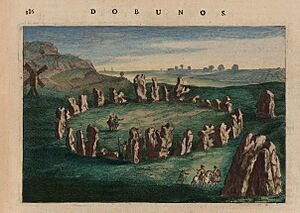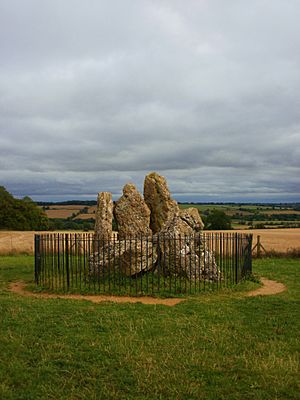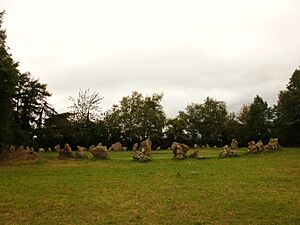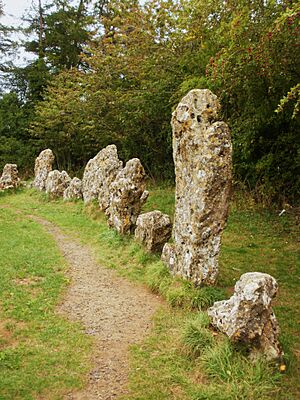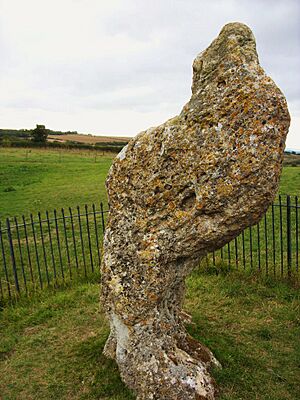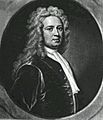Rollright Stones facts for kids
Quick facts for kids Rollright Stones |
|
|---|---|
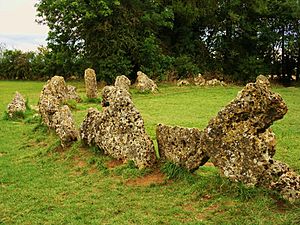
Part of the King's Men stone circle,
one of three monuments at the site |
|
| Type | Dolmen, Stone circle and monolith |
| Official name: The Rollright Stones | |
| Designated | 18 August 1882 |
| Reference no. | 1018400 |
| Lua error in Module:Location_map at line 420: attempt to index field 'wikibase' (a nil value). | |
The Rollright Stones are a group of three ancient stone monuments. They were built a very long time ago, during the Neolithic (New Stone Age) and Bronze Age periods. You can find them near the village of Long Compton, right on the border between Oxfordshire and Warwickshire in England.
These three monuments are called the King's Men, the Whispering Knights, and the King Stone. They are all made from local stone called oolitic limestone. Each one is unique and was built for a different reason. They were also built at different times over thousands of years.
The Whispering Knights was built first, around 4,000 to 2,500 BCE. It was probably used as a burial place. Next came the King's Men, a large stone circle. It was built later, between 2,500 and 800 BCE. The King Stone is a single tall stone, and archaeologists think it might have been a marker for a grave from the Bronze Age.
People have told many stories about the Rollright Stones for hundreds of years. One famous legend says that a king and his knights were turned into stone by a witch! Today, the stones are a protected historical site. They are also a special place for people who follow modern Pagan religions, who sometimes hold ceremonies there.
| Top - 0-9 A B C D E F G H I J K L M N O P Q R S T U V W X Y Z |
Where Are the Rollright Stones Located?
The Rollright Stones are found on the border of Oxfordshire and Warwickshire. They are about two-and-a-half miles northwest of Chipping Norton. They sit on a hill called the Cotswold Hills. This spot offers great views of the valleys nearby.
The stones themselves are made from a type of limestone found in this area. This stone was formed millions of years ago.
Why Were These Ancient Stones Built?
Long ago, around 4,000 BCE, big changes happened in Britain. People started farming instead of just hunting and gathering food. They also began to build the first large monuments. This shows that people were thinking differently about their world.
Early Stone Age Monuments
During the early and middle parts of the Stone Age (Neolithic period), people built huge stone tombs. These tombs held the bodies of the dead. Archaeologists believe these tombs were important for rituals about death. They also think they were used to honor ancestors.
These large stone tombs are found across Europe. Many archaeologists think they were made to look like the long wooden houses built by early farmers. These tombs were more than just places for bones. They were like shrines where people held special ceremonies.
Later Stone Age Changes
Later in the Stone Age, British society changed again. People stopped building the large tombs. Instead, they started building big circles of wood or stone. Hundreds of these circles were built across Britain and Ireland. This suggests that people's religious beliefs were changing.
How Were the Rollright Stones Built?
The Rollright Stones are three separate monuments. They were built over a long time, during the Stone Age and Bronze Age. Their names come from old stories. These names are now used by archaeologists too.
The stones used for the monuments are a local type of limestone. Experts believe these stones were found naturally on the ground. They were not dug out of a quarry. The builders likely found them on the hillsides.
Moving these huge stones uphill was a big job. Archaeologists think the ancient builders used wooden sledges. They might have put logs under the sledges to roll them. This would have made it easier to drag the heavy stones.
Experts believe building the Rollright Stones did not take a huge amount of effort. It would have been much less work than building other famous sites like Stonehenge.
The Whispering Knights: An Ancient Burial Place
The Whispering Knights is thought to be the oldest of the Rollright Stones. It is about 400 meters east of the King's Men. It is what's left of an ancient burial chamber. Only four standing stones remain. They form a small room with a fifth stone lying down, which was probably the roof.
Archaeologists have studied the Whispering Knights for centuries. In the 1980s, excavations found some pieces of Stone Age pottery. Raising the capstone (roof stone) for the Whispering Knights was likely the hardest part of building the Rollright Stones. Builders probably used a ramp made of stones. They would have pulled the capstone up the ramp using rollers.
The King's Men: A Stone Circle
The King's Men is a large stone circle, about 33 meters wide. It has 77 stones that are close together. When it was first built, it was probably a more perfect circle. The stones might have even touched each other. The builders likely placed the smoother sides of the stones to face inwards.
Surveys of the ground inside the circle show some interesting spots. These might be old pits or places where fires were lit. Archaeologists also found no signs of a large ditch around the circle.
Building the King's Men would have taken a team of 10 to 20 workers. It would have been about three weeks of work for them. This includes digging holes for the stones and moving the timber.
Some of the stones in the King's Men were put back up in 1882. Some new stones were also added to fill gaps. Today, only a few of the standing stones are modern additions. Some smaller stones were stolen by vandals in the 20th century.
The King Stone: A Mysterious Single Stone
The King Stone is a single tall stone, about 2.4 meters high. It stands 76 meters north of the King's Men. We don't know exactly when it was built. People have many ideas about what it was for.
Some thought it was an astronomical marker. But it only lines up with one star, Capella, which might not have been important to ancient Britons. Others thought it was a landmark or a guidepost. But its position makes it hard to see.
Archaeologists now think the King Stone was a marker for a burial site. This is because other Bronze Age burial mounds are found nearby. When it was first put up, the King Stone probably weighed about 4.7 tons. A team of about 58 workers could have set it up in about two hours.
The Legends of the Rollright Stones
Many old stories are told about the Rollright Stones. One famous tale was written down in 1610. It says a king was riding with his army when a witch named Mother Shipton stopped him.
She told him:
Seven long strides thou shalt take, says she
And if Long Compton thou canst see,
King of England thou shalt be!
The king took seven steps, but a hill blocked his view of Long Compton. The witch laughed and said:
As Long Compton thou canst not see, King of England thou shalt not be! Rise up stick and stand still stone, For King of England thou shalt be none; Thou and thy men hoar stones shall be, And I myself an elder tree!
The king became the single King Stone. His soldiers became the King's Men stone circle. The witch then turned four of his knights, who were whispering behind him, into the Whispering Knights.
Later Legends and Beliefs
People used to believe that the King Stone came alive at midnight. They also said the king and his men would come alive on certain special days.
In the 18th and 19th centuries, the Rollright Stones became linked to ideas about good luck for families. Girls would run around the stones at midnight on Midsummer's Eve. They hoped to see the person they would marry. Some people also believed that listening to the stones would tell them who their future husband would be.
Studying and Protecting the Stones
The first known written record of the Rollright Stones is from the 14th century. An old book called The Wonders of Britain mentioned them. It said that no one knew when or why they were built.
Early Explorers and Maps
In the 16th century, more people started writing about the stones. One early explorer, John Leland, mentioned them in his travel notes. Another, William Camden, wrote about the stones and their legends in his book Britannia. He even wondered if they were built to remember a victory by a Viking leader.
An old tapestry map from the 1580s, called the Sheldon Tapestry Map, is thought to be the first map to show the Rollright Stones.
Modern Archaeological Work
In the 1980s, a big study of the Rollright Stones began. Archaeologists and historians worked together. They looked at old maps, drawings, and aerial photos. They also used special equipment to scan the ground.
Then, they carefully dug small areas to find artifacts. They found tools, pottery, plant remains, and even bones. This helped them learn much more about the site. All this research was put into a detailed book in 1988. It became the first full report on the Rollright Stones.
The Rollright Stones Today
The Rollright Stones are a very important place for people who follow modern Pagan religions. Since the 1950s, different Pagan groups have held rituals and ceremonies there. They often choose the site because of its old legends about witches and magic.
Many Pagans go to the stones to meditate. They believe they can connect with spirits there. Some also leave small gifts, like flowers or fruit. However, some actions, like putting coins in cracks or making fires, can damage the stones.
Earth Mysteries and Ley Lines
The stones also attract people interested in "Earth Mysteries." Some believe the Rollright Stones are part of invisible energy lines called "ley lines." These lines are thought to connect ancient sites.
One group even studied the site in the 1970s. They found unusual sound patterns at the King Stone. They thought the King's Men circle might block some natural sounds.
Protecting the Stones for the Future
In the 1990s, the owner of the site decided to sell it. People worried that the stones might be turned into a tourist attraction or closed off. So, a group created a charity called the Rollright Trust in 1997.
The Trust raised money and bought the stones in 2001. They now manage the site to protect it. They charge a small fee to visit the King's Men circle. They also try to prevent damage to the stones. They have made paths better for wheelchairs.
Sadly, there has been some vandalism. In 2001, a piece of the King Stone was chipped off. In 2004, paint was splashed on the King's Men. The Trust has also faced challenges, like their wardens' hut being damaged by fire.
The Rollright Trust works with many different groups, including archaeologists and Pagans. They allow Pagan groups to book times for ceremonies. This helps ensure everyone can enjoy and respect this ancient and special place.
Images for kids


